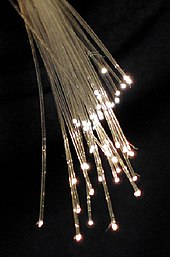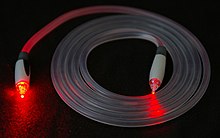

An optical fiber, or optical fibre, is a flexible glass or plastic fiber that can transmit light[a] from one end to the other. Such fibers find wide usage in fiber-optic communications, where they permit transmission over longer distances and at higher bandwidths (data transfer rates) than electrical cables. Fibers are used instead of metal wires because signals travel along them with less loss and are immune to electromagnetic interference.[1] Fibers are also used for illumination and imaging, and are often wrapped in bundles so they may be used to carry light into, or images out of confined spaces, as in the case of a fiberscope.[2] Specially designed fibers are also used for a variety of other applications, such as fiber optic sensors and fiber lasers.[3]
Glass optical fibers are typically made by drawing, while plastic fibers can be made either by drawing or by extrusion.[4][5] Optical fibers typically include a core surrounded by a transparent cladding material with a lower index of refraction. Light is kept in the core by the phenomenon of total internal reflection which causes the fiber to act as a waveguide.[6] Fibers that support many propagation paths or transverse modes are called multi-mode fibers, while those that support a single mode are called single-mode fibers (SMF).[7] Multi-mode fibers generally have a wider core diameter[8] and are used for short-distance communication links and for applications where high power must be transmitted.[9] Single-mode fibers are used for most communication links longer than 1,050 meters (3,440 ft).[10]
Being able to join optical fibers with low loss is important in fiber optic communication.[11] This is more complex than joining electrical wire or cable and involves careful cleaving of the fibers, precise alignment of the fiber cores, and the coupling of these aligned cores. For applications that demand a permanent connection a fusion splice is common. In this technique, an electric arc is used to melt the ends of the fibers together. Another common technique is a mechanical splice, where the ends of the fibers are held in contact by mechanical force. Temporary or semi-permanent connections are made by means of specialized optical fiber connectors.[12]
The field of applied science and engineering concerned with the design and application of optical fibers is known as fiber optics. The term was coined by Indian-American physicist Narinder Singh Kapany.[13]
Cite error: There are <ref group=lower-alpha> tags or {{efn}} templates on this page, but the references will not show without a {{reflist|group=lower-alpha}} template or {{notelist}} template (see the help page).
- ^ Senior, John M.; Jamro, M. Yousif (2009). Optical fiber communications: principles and practice. Pearson Education. pp. 7–9. ISBN 978-0130326812.
- ^ "Birth of Fiberscopes". www.olympus-global.com. Olympus Corporation. Retrieved 17 April 2015.
- ^ Lee, Byoungho (2003). "Review of the present status of optical fiber sensors". Optical Fiber Technology. 9 (2): 57–79. Bibcode:2003OptFT...9...57L. doi:10.1016/s1068-5200(02)00527-8.
- ^ "Optical Fiber". www.thefoa.org. The Fiber Optic Association. Retrieved 17 April 2015.
- ^ "Manufacture of Perfluorinated Plastic Optical Fibers" (PDF). chromisfiber.com. 2004. Retrieved 2023-09-11.
- ^ Senior, pp. 12–14
- ^ Pearsall, Thomas (2010). Photonics Essentials (2nd ed.). McGraw-Hill. ISBN 978-0-07-162935-5. Archived from the original on 2021-08-17. Retrieved 2021-02-24.
- ^ The Optical Industry & Systems Purchasing Directory. Optical Publishing Company. 1984.
- ^ Hunsperger (2017-10-19). Photonic Devices and Systems. Routledge. ISBN 9781351424844.
- ^ Fennelly, Lawrence J. (26 November 2012). Effective Physical Security (4th ed.). Elsevier Science. p. 355. ISBN 9780124159815.
- ^ Senior, p. 218
- ^ Senior, pp. 234–235
- ^ "Narinder Singh Kapany Chair in Opto-electronics". ucsc.edu. Archived from the original on 2017-05-21. Retrieved 2016-11-01.